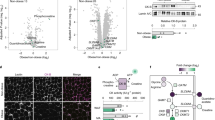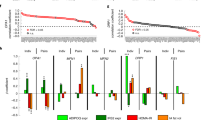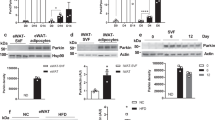Abstract
Background/Objectives:
We aimed to evaluate mitochondrial biogenesis (MB), structure, metabolism and dysfunction in abdominal adipose tissue from male pediatric patients with obesity.
Subjects/Methods:
Samples were collected from five children with obesity (percentile ⩾95) and five eutrophic boys (percentile ⩾5/⩽85) (8–12 years old) following parental informed consent. We analyzed the expression of key genes involved in MB (sirtuin-1 (SIRT1), peroxisome proliferator-activated receptor-γ (PPARγ), PPARγ coactivator-1α (PGC1α), nuclear respiratory factors 1 and 2 (NRF1, NRF2) and mitochondrial transcription factor A (TFAM) and surrogates for mitochondrial function/structure/metabolism (porin, TOMM20, complex I and V, UCP1, UCP2, SIRT3, SOD2) by western blot. Citrate synthase (CS), complex I (CI) activity, adenosine triphosphate (ATP) levels, mitochondrial DNA (mtDNA) content and oxidative stress end points were also determined.
Results:
Most MB proteins were significantly decreased in samples from children with obesity except complex I, V and superoxide dismutase-2 (SOD2). Similarly, CS and CI activity showed a significant reduction, as well as ATP levels and mtDNA content. PPARγ, PGC1α, complex I and V and SOD2 were hyperacetylated compared with lean samples. Concurrently, in samples from children with obesity, we found decreased SOD2 activity and redox state imbalance highlighted by decreased reduced glutathione/oxidized glutathione (GSH/GSSG) ratio and significant increases in protein carbonylation.
Conclusions:
Adipose tissue from children with obesity demonstrates a dysregulation of key modulators of MB and organelle structure, and displays hyperacetylation of key proteins and altered expression of upstream regulators of cell metabolism.
This is a preview of subscription content, access via your institution
Access options
Subscribe to this journal
Receive 12 print issues and online access
$259.00 per year
only $21.58 per issue
Buy this article
- Purchase on Springer Link
- Instant access to full article PDF
Prices may be subject to local taxes which are calculated during checkout





Similar content being viewed by others
References
Lipek T, Igel U, Gausche R, Kiess W, Grande G . Obesogenic environments: environmental approaches to obesity prevention. J Pediatr Endocrinol Metab 2015; 28: 485–495.
Martin A, Saunders DH, Shenkin SD, Sproule J . Lifestyle intervention for improving school achievement in overweight or obese children and adolescents. Cochrane Database Syst Rev 2014; 3: CD009728.
Messiah SE, Lipshultz SE, Natale RA, Miller TL . The imperative to prevent and treat childhood obesity: why the world cannot afford to wait. Clin Obes 2013; 3: 163–171.
Gutiérrez JP, Rivera-Dommarco JA, Shamah-Levy T, Villalpando-Hernández S, Franco A, Cuevas-Nasu L et al Encuesta Nacional de Salud y Nutrición 2012. Resultados Nacionales. 2a. ed. [Internet]. Instituto Nacional de Salud Publica. 2013.
Boudina S, Graham TE . Mitochondrial function/dysfunction in white adipose tissue. Exp Physiol 2014; 99: 1168–1178.
Arruda AP, Pers BM, Parlakgül G, Güney E, Inouye K, Hotamisligil GS . Chronic enrichment of hepatic endoplasmic reticulum-mitochondria contact leads to mitochondrial dysfunction in obesity. Nat Med 2014; 20: 1427–1435.
Weisberg SP, McCann D, Desai M, Rosenbaum M, Leibel RL, Ferrante AW . Obesity is associated with macrophage accumulation in adipose tissue. J Clin Invest 2003; 112: 1796–1808.
Kraunsøe R, Boushel R, Hansen CN, Schjerling P, Qvortrup K, Støckel M et al. Mitochondrial respiration in subcutaneous and visceral adipose tissue from patients with morbid obesity. J Physiol 2010; 588: 2023–2032.
Hansen M, Lund MT, Gregers E, Kraunsøe R, Van Hall G, Helge JW et al. Adipose tissue mitochondrial respiration and lipolysis before and after a weight loss by diet and RYGB. Obesity (Silver Spring) 2015; 23: 2022–2029.
Muoio DM, Neufer PD . Lipid-induced mitochondrial stress and insulin action in muscle. Cell Metab 2012; 15: 595–605.
Brownlee M . Biochemistry and molecular cell biology of diabetic complications. Nature 2001; 414: 813–820.
Zhang D, Liu Z-X, Choi CS, Tian L, Kibbey R, Dong J et al. Mitochondrial dysfunction due to long-chain Acyl-CoA dehydrogenase deficiency causes hepatic steatosis and hepatic insulin resistance. Proc Natl Acad Sci USA 2007; 104: 17075–17080.
Petersen KF, Dufour S, Shulman GI . Decreased insulin-stimulated ATP synthesis and phosphate transport in muscle of insulin-resistant offspring of type 2 diabetic parents. PLoS Med 2005; 2: 0879–0884.
Befroy DE, Petersen KF, Dufour S, Mason GF, de Graaf RA, Rothman DL et al. impaired mitochondrial substrate oxidation in muscle of insulin-resistant offspring of type 2 diabetic patients. Diabetes 2007; 56: 1376–1381.
Patti ME, Butte AJ, Crunkhorn S, Cusi K, Berria R, Kashyap S et al. Coordinated reduction of genes of oxidative metabolism in humans with insulin resistance and diabetes: potential role of PGC1 and NRF1. Proc Natl Acad Sci USA 2003; 100: 8466–8471.
Petersen KF, Dufour S, Befroy D, Garcia RSG . Impaired mitochondrial activity in the insulin-resistant offspring of patients with type 2 diabetes. N Engl J Med 2004; 9: 223–224.
Civitarese AE, Ukropcova B, Carling S, Hulver M, DeFronzo RA, Mandarino L et al. Role of adiponectin in human skeletal muscle bioenergetics. Cell Metab 2006; 4: 75–87.
De Pauw A, Tejerina S, Raes M, Keijer J, Arnould T . Mitochondrial (dys)function in adipocyte (de)differentiation and systemic metabolic alterations. Am J Pathol 2009; 175: 927–939.
Costa CDS, Hammes TO, Rohden F, Margis R, Bortolotto JW, Padoin AV et al. SIRT1 transcription is decreased in visceral adipose tissue of morbidly obese patients with severe hepatic steatosis. Obes Surg 2010; 20: 633–639.
Hirschey MD, Shimazu T, Huang J-Y, Schwer B, Verdin E . SIRT3 regulates mitochondrial protein acetylation and intermediary metabolism. Cold Spring Harb Symp Quant Biol 2011; 76: 267–277.
He W, Barak Y, Hevener A, Olson P, Liao D, Le J et al. Adipose-specific peroxisome proliferator-activated receptor gamma knockout causes insulin resistance in fat and liver but not in muscle. Proc Natl Acad Sci USA 2003; 100: 15712–15717.
Sies H . Glutathione and its role in cellular functions. Free Radic Biol Med 1999; 27: 916–921.
Scarpulla RC . Metabolic control of mitochondrial biogenesis through the PGC-1 family regulatory network. Biochim Biophys Acta Mol Cell Res 2011; 1813: 1269–1278.
Cantó C, Auwerx J . PGC-1alpha, SIRT1 and AMPK, an energy sensing network that controls energy expenditure. Curr Opin Lipidol 2009; 20: 98–105.
Banks AS, Kon N, Knight C, Matsumoto M, Gutiérrez-Juárez R, Rossetti L et al. SirT1 gain of function increases energy efficiency and prevents diabetes in mice. Cell Metab 2008; 8: 333–341.
Gillum MP, Kotas ME, Erion DM, Kursawe R, Chatterjee P, Nead KT et al. SirT1 regulates adipose tissue inflammation. Diabetes 2011; 60: 3235–3245.
Yoshizaki T, Milne JC, Imamura T, Schenk S, Sonoda N, Babendure JL et al. SIRT1 exerts anti-inflammatory effects and improves insulin sensitivity in adipocytes. Mol Cell Biol 2009; 29: 1363–1374.
Shoar Z, Goldenthal MJ, De Luca F, Suarez E . Mitochondrial DNA content and function, childhood obesity, and insulin resistance. Endocr Res 2016; 41: 49–56.
Gerhart-Hines Z, Rodgers JT, Bare O, Lerin C, Kim S-H, Mostoslavsky R et al. Metabolic control of muscle mitochondrial function and fatty acid oxidation through SIRT1/PGC-1α. EMBO J 2007; 26: 1913–1923.
Feldmann HM, Golozoubova V, Cannon B, Nedergaard J . UCP1 ablation induces obesity and abolishes diet-induced thermogenesis in mice exempt from thermal stress by living at thermoneutrality. Cell Metab 2009; 9: 203–209.
Langin D, Larrouy D, Barbe P, Millet L, Viguerie-Bascands N, Andreelli F et al. Uncoupling protein-2 (UCP2) and uncoupling protein-3 (UCP3) expression in adipose tissue and skeletal muscle in humans. Int J Obes Relat Metab Disord 1999; 23 (Suppl 6): S64–S67.
Thompson MP, Kim D . Links between fatty acids and expression of UCP2 and UCP3 mRNAs. FEBS Lett 2004; 568: 4–9.
Skulachev VP . Uncoupling: new approaches to an old problem of bioenergetics. Biochim Biophys Acta 1998; 1363: 100–124.
Pecqueur C, Alves-Guerra MC, Gelly C, Lévi-Meyrueis C, Couplan E, Collins S et al. Uncoupling protein 2, in vivo distribution, induction upon oxidative stress, and evidence for translational regulation. J Biol Chem 2001; 276: 8705–8712.
Mahadik SR, Lele RD, Saranath D, Seth A, Parikh V . Uncoupling protein-2 (UCP2) gene expression in subcutaneous and omental adipose tissue of Asian Indians. Adipocyte 2012; 1: 101–107.
Joseph A-M, Joanisse DR, Baillot RG, Hood DA . Mitochondrial dysregulation in the pathogenesis of diabetes: potential for mitochondrial biogenesis-mediated interventions. Exp Diabetes Res 2012; 2012: 642038.
Srere PA . [1] Citrate synthase. [EC 4.1.3.7. Citrate oxaloacetate-lyase (CoA-acetylating)]. Methods Enzymol 1969; 13: 3–11.
Christe M, Hirzel E, Lindinger A, Kern B, von Flüe M, Peterli R et al. Obesity affects mitochondrial citrate synthase in human omental adipose tissue. ISRN Obes 2013; 2013: 1–8.
Vieira VJ, Valentine RJ . Mitochondrial biogenesis in adipose tissue: can exercise make fat cells ‘fit’? J Physiol 2009; 587: 3427–3428.
Kaaman M, Sparks LM, van Harmelen V, Smith SR, Sjölin E, Dahlman I et al. Strong association between mitochondrial DNA copy number and lipogenesis in human white adipose tissue. Diabetologia 2007; 50: 2526–2533.
Chattopadhyay M, GuhaThakurta I, Behera P, Ranjan KR, Khanna M, Mukhopadhyay S et al. Mitochondrial bioenergetics is not impaired in nonobese subjects with type 2 diabetes mellitus. Metabolism 2011; 60: 1702–1710.
Norvell A, McMahon SB . Rise of the rival. Science 2010; 327: 964–965.
Qiu X, Brown K, Hirschey MD, Verdin E, Chen D . Calorie restriction reduces oxidative stress by SIRT3-mediated SOD2 activation. Cell Metab 2010; 12: 662–667.
Tao R, Coleman MC, Pennington JD, Ozden O, Park S-H, Jiang H et al. Sirt3-mediated deacetylation of evolutionarily conserved lysine 122 regulates MnSOD activity in response to stress. Mol Cell 2010; 40: 893–904.
Fernandez-Marcos PJ, Auwerx J . Regulation of PGC-1, a nodal regulator of mitochondrial biogenesis. Am J Clin Nutr 2011; 93: 884S–890S.
Lombard DB, Alt FW, Cheng H-L, Bunkenborg J, Streeper RS, Mostoslavsky R et al. Mammalian Sir2 homolog SIRT3 regulates global mitochondrial lysine acetylation. Mol Cell Biol 2007; 27: 8807–8814.
Hirschey MD, Shimazu T, Goetzman E, Jing E, Schwer B, Lombard DB et al. SIRT3 regulates mitochondrial fatty-acid oxidation by reversible enzyme deacetylation. Nature 2010; 464: 121–125.
Ahn B-H, Kim H-S, Song S, Lee IH, Liu J, Vassilopoulos A et al. A role for the mitochondrial deacetylase Sirt3 in regulating energy homeostasis. Proc Natl Acad Sci USA 2008; 105: 14447–14452.
Shimazu T, Hirschey MD, Hua L, Dittenhafer-Reed KE, Schwer B, Lombard DB et al. SIRT3 deacetylates mitochondrial 3-hydroxy-3-methylglutaryl CoA synthase 2 and regulates ketone body production. Cell Metab 2010; 12: 654–661.
Xu H, Barnes GT, Yang Q, Tan G, Yang D, Chou CJ et al. Chronic inflammation in fat plays a crucial role in the development of obesity-related insulin resistance. J Clin Invest 2003; 112: 1821–1830.
Liu Y, Qi W, Richardson A, Van Remmen H, Ikeno Y, Salmon AB . Oxidative damage associated with obesity is prevented by overexpression of CuZn- or Mn-superoxide dismutase. Biochem Biophys Res Commun 2013; 438: 78–83.
Kobayashi H, Matsuda M, Fukuhara A, Komuro R, Shimomura I . Dysregulated glutathione metabolism links to impaired insulin action in adipocytes. Am J Physiol Endocrinol Metab 2009; 296: E1326–E1334.
Frohnert BI, Sinaiko AR, Serrot FJ, Foncea RE, Moran A, Ikramuddin S et al. Increased adipose protein carbonylation in human obesity. Obesity (Silver Spring) 2011; 19: 1735–1741.
Acknowledgements
This work was supported by CONACyT (SALUD-2009-01-111494). FV is a co-founder and stockholder in Cardero Therapeutics Inc.
Author information
Authors and Affiliations
Corresponding author
Ethics declarations
Competing interests
The authors declare no conflict of interest.
Additional information
Supplementary Information accompanies this paper on International Journal of Obesity website
Supplementary information
Rights and permissions
About this article
Cite this article
Zamora-Mendoza, R., Rosas-Vargas, H., Ramos-Cervantes, M. et al. Dysregulation of mitochondrial function and biogenesis modulators in adipose tissue of obese children. Int J Obes 42, 618–624 (2018). https://doi.org/10.1038/ijo.2017.274
Received:
Revised:
Accepted:
Published:
Issue Date:
DOI: https://doi.org/10.1038/ijo.2017.274
This article is cited by
-
Precision nutrition to reset virus-induced human metabolic reprogramming and dysregulation (HMRD) in long-COVID
npj Science of Food (2024)
-
The potential of therapeutic strategies targeting mitochondrial biogenesis for the treatment of insulin resistance and type 2 diabetes mellitus
Archives of Pharmacal Research (2024)
-
White adipose tissue mitochondrial bioenergetics in metabolic diseases
Reviews in Endocrine and Metabolic Disorders (2023)
-
Childhood overeating is associated with adverse cardiometabolic and inflammatory profiles in adolescence
Scientific Reports (2021)
-
Maternal obesity during pregnancy leads to adipose tissue ER stress in mice via miR-126-mediated reduction in Lunapark
Diabetologia (2021)



